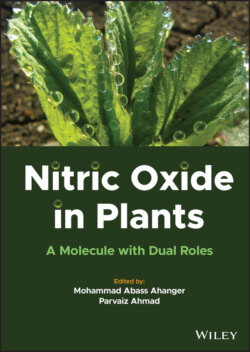Читать книгу Nitric Oxide in Plants - Группа авторов - Страница 9
1.1.1 Historical Evidence and Biosynthesis of Nitric Oxide
ОглавлениеSeveral studies have been conducted over the past several decades to investigate the presence and characteristics of NO gas in living beings. Gas, as a versatile molecule, has piqued curiosity and opened up new opportunities for research. NO gas is an atom gas with well-defined communication roles in mammalian systems, serving as a second messenger during vasorelaxation, neurotransmission, immunity, and toxicity. It is now clear that NO performs a critical role in animal physiology. Because of its extensive biological relevance, NO was designated “Molecule of the Year” in 1992 by Science, and Furchgott, Murad, and Ignarro were given the Nobel Prize in Physiology and Medicine in 1998. Furchgott discovered in 1980 that an unknown molecule found in animal tissue could relax smooth muscle cells, and he dubbed it EDRF (endothelium-derived reposeful factor). Murad discovered years ago that vasodilators activate guanylate cyclase (GC), which creates cyclic guanosine monophosphate and relaxes muscle fibers. This discovery begged the question of how a vasodilator outside the cell could influence a catalyst inside the cell. The solution was that the vasodilator was tainted with NO residues. Murad then bubbled NO gas across swish muscle cells, activating gigacycles per second. Thus, even before eukaryotes were thought to produce NO, he postulated that hormones may regulate swish muscles via NO. Years later, Ignarro demonstrated that NO has comparable chemical behavior to EDRF and is, in fact, a twin of EDRF. NO release from plants was initially suspected by Klepper in soybeans in 1975, much earlier than in mammals (Klepper 1979). The vast biological importance of gas in plants was established in the 1990s (Gouvea et al. 1997; Leshem et al. 1998).
In animals, NO has since been recognized as an important signaling molecule in maintaining blood pressure within the circulatory system, stimulating host defenses within the system, controlling neural transmission within the brain, controlling organic phenomena, protoplasm aggregation, learning and memory, male sexual function, toxicity and cytoprotection, the development of artery hardening, and a variety of other functions. It functions as a secondary transmitter in mammalian systems during vasorelaxation, neurotransmission, immunity, and toxicity. As a result, they play critical roles in animal physiology.
However, unlike animal physiology, the physiology and chemical chemistry of NO in plants is less well known. NO has the potential to be a dynamic bioactive molecule that plays an important physiological role in plants and animals.
